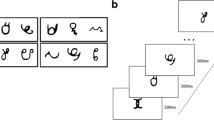Abstract
In two experiments on equivalence class formation subjects were taught arbitrary trained relations between icons of familiar objects by matching-to-sample on a computer screen, before receiving four blocks of tests for trained and emergent relations. There were six AB/BC training sets so that potentially six ABC equivalence classes would be formed. In Experiment 1, an early discordant group of subjects was taught, prior to testing, oral paired associations between the names which the individual subjects gave to the A and the B visual stimuli in combinations which were systematically discordant with the AB matching-to-sample-based trained relations. In a second late discordant group, discordant paired associates were taught after two blocks of tests and in a third control group no discordant associations were taught. In the early discordant group it was found that paired associate-based links substituted for matching-to-sample-based links in many choices in all types of tests in which they could be implicated so that there was a significantly lower proportion than in the other two groups of choices consistent with equivalence class formation based upon the matching-to-sample training. It was found that for the late discordant group paired associate-based relations did not displace matching-to sample-based relations. A high proportion of choices continued to be consistent with equivalence classes based upon the preliminary matching-to-sample training, as was found in the control group. In a second experiment with interpolated paired associate-like training using the visual stimuli themselves (rather than their names) in a similar early versus late design it was found that choices based on discordant visual relations displaced a considerable proportion of choices based on matching to sample training, whether interpolated before or after some initial matching to sample testing. These results suggest that subjects’ names for individual stimuli may play a role in the formation of equivalence classes but play little part in the maintenance of such classes once formed.
Similar content being viewed by others
References
BENTALL, R. P., DICKINS, D. W., & FOX, S. R. A. (1993). Naming and equivalence: Response latencies for emergent relations. Quarterly Journal of Experimental Psychology, 46B, 187–214.
DICKINS, D. W., BENTALL, R. P., & SMITH, A. B. (1993). The role of individual stimulus names in the emergence of equivalence relations: The effects of paired-associates training between names. The Psychological Record, 43, 713–724.
DUGDALE, N., & LOWE, C. F. (1990). Naming and stimulus equivalence. In D. E. Blackman & H. Lejeune (Eds.), Behaviour analysis in theory and practice (pp. 115–138). Hove: Lawrence Erlbaum.
FIELDS, L., ADAMS, B. J., VERHAVE, T., & NEWMAN, S. (1990). The effects of nodality on the formation of equivalence sets. Journal of the Experiments Analysis of Behavior, 53, 345–358.
FIELDS, L., & NEVIN, J. A. (1993). Stimulus equivalence: A special issue of praired-associates training between names. The Psychological Record, 43(4), 541–844.
FIELDS, L., & VERHAVE, T. (1987). The structure of equivalence classes. Journal of the Experimental Analysis of Behavior, 48, 317–332.
HAYES, S. C. (1992). Verbal relations and the evolution of behavior analysis. American Psychologist, 47, 1383–1395.
LAZAR, R. M., DAVIS-LANG, D., & SANCHEZ, L. (1984). The formulation of visual stimulus equivalences in children. Journal of the Experimental Analysis of Behavior, 41, 251–266.
PILGRIM, C., & GALIZIO, M. (1990). Relations between baseline contingencies and equivalence probe performances. Journal of the Experimental Analysis of Behavior, 54, 213–224.
SAUNDERS, R. R., SAUNDERS, K. J., KIRBY, K. C., & SPRADLIN, J. E. (1988). The merger and development of equivalence classes by unreinforced conditional selection of comparison stimuli. Journal of the Experimental Analysis of Behavior, 50, 145–162.
SIDMAN, M., KIRK, B., & WILLSON-MORRIS, M. (1985). Six-member stimulus classes generated by conditional-discrimination procedures. Journal of the Experimental Analysis of Behavior, 43, 21–42.
SIDMAN, M., & TAILBY, W. (1982). Conditional discrimination vs matching to sample: An expansion of the testing paradigm. Journal of the Experimental Analysis of Behavior, 37, 5–52.
SPRADLIN, J. E., COTTER, V. W., & BAXLEY, N. (1973). Establishing a conditional discrimination without direct training: A study of transfer with retarded adolescents. American Journal of Mental Deficiency, 11, 556–566.
WULFERT, E., & HAYES, S. C. (1988). Transfer of a conditional ordering response through conditional equivalence classes. Journal of the Experimental Analysis of Behavior, 50, 125–144.
Author information
Authors and Affiliations
Corresponding author
Rights and permissions
About this article
Cite this article
Smith, A.B., Dickins, D.W. & Bentall, R.P. The Role of Individual Stimulus Names in the Emergence of Equivalence Relations II: The Effects of Interfering Tasks Prior to and After Tests for Emergent Relations. Psychol Rec 46, 109–130 (1996). https://doi.org/10.1007/BF03395166
Published:
Issue Date:
DOI: https://doi.org/10.1007/BF03395166




